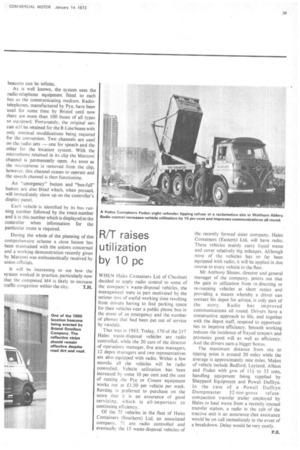R/T raises utilization by 10 pc
Page 41

If you've noticed an error in this article please click here to report it so we can fix it.
WHEN Hales Containers Ltd of Cheshunt decided to apply radio control to some of the company's waste-disposal vehicles, the management were in part motivated by the serious loss of useful working time resulting from drivers having to find parking space for their vehicles near a public phone box in the event of an emergency and the number of phones that had been put out of service by vandals.
That was in 1965. Today, 170 of the 217 Hales waste-disposal vehicles are radio controlled. while the 20 cars of the director of operations manager, five area managers, 12 depot managers and two representatives are also equipped with radio. Within a few months all the vehicles will be radio controlled. Vehicle utilization has been increased by some 10 per cent and the cost of renting the Pye or Cossor equipment works out at .E1.50 per vehicle per week. Renting is preferred to purchase on the score that it is an assurance of good servicing, which is all-important to continuing efficiency.
Of the 75 vehicles in the fleet of Hales Containers (Southern) Ltd, an associated company. 71 are radio controlled and eventually the 15 waste-disposal vehicles of the recently formed sister company, Hales Containers (Eastern) Ltd, will have radio. These vehicles mainly carry liquid waste and cover relatively big mileages. Although none of the vehicles has so far been equipped with radio, it will be applied in due course to every vehicle in the fleet.
Mr Anthony Shutes, director and general manager of the company, points out that the gain in utilization from re directing or re-routeing vehicles at short notice and providing a means whereby a driver can contact his depot for advice, is only part of the story. Radio has improved communications all round. Drivers have a constructive approach to life, and together with the depot staff, respond to opportunities to improve efficiency. Smooth working reduces the incidence of frayed tempers and promotes good will as well as efficiency: And the drivers earn .a bigger bonus.
The maximum distance from site to tipping point is around 20 miles while the average is approximately nine miles.. Makes of vehicle include Bedford, Leyland. Albion and Foden with gvw of 11; to 32 tons, handling equipment being supplied by Sheppard Equipment and Powell Duffryn. In the case of a Powell Duffryn Dumpmaster 32-ton-gross refusecompaction transfer trailer employed by Hales to haul waste from a recently opened transfer station, a radio in the cab of the tractive unit is an assurance that assistance would be on call immediately in the event of a breakdown. Delay would be very costly.
















































































































